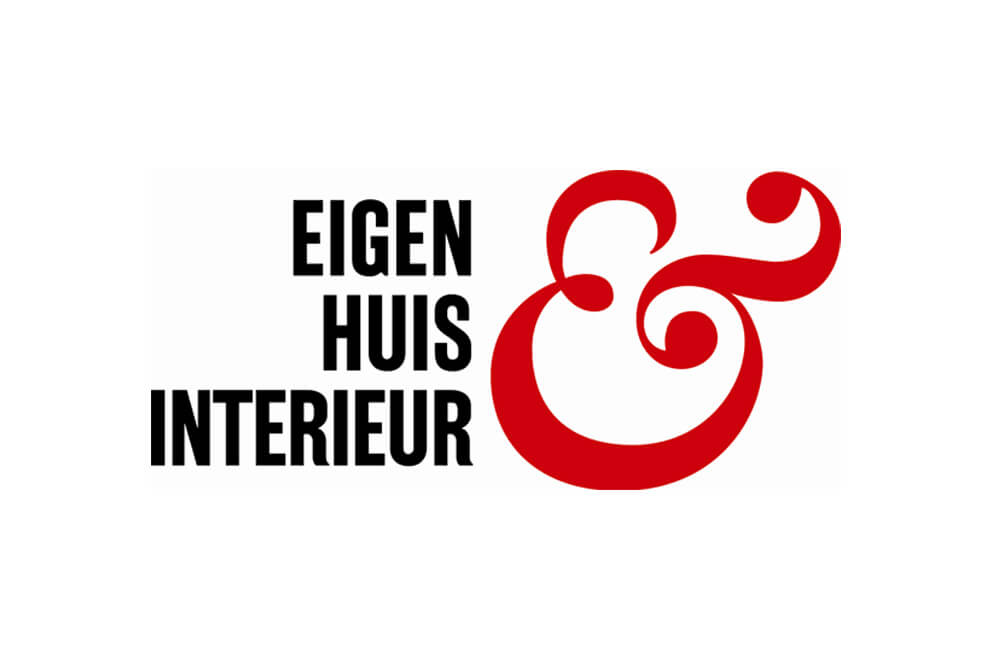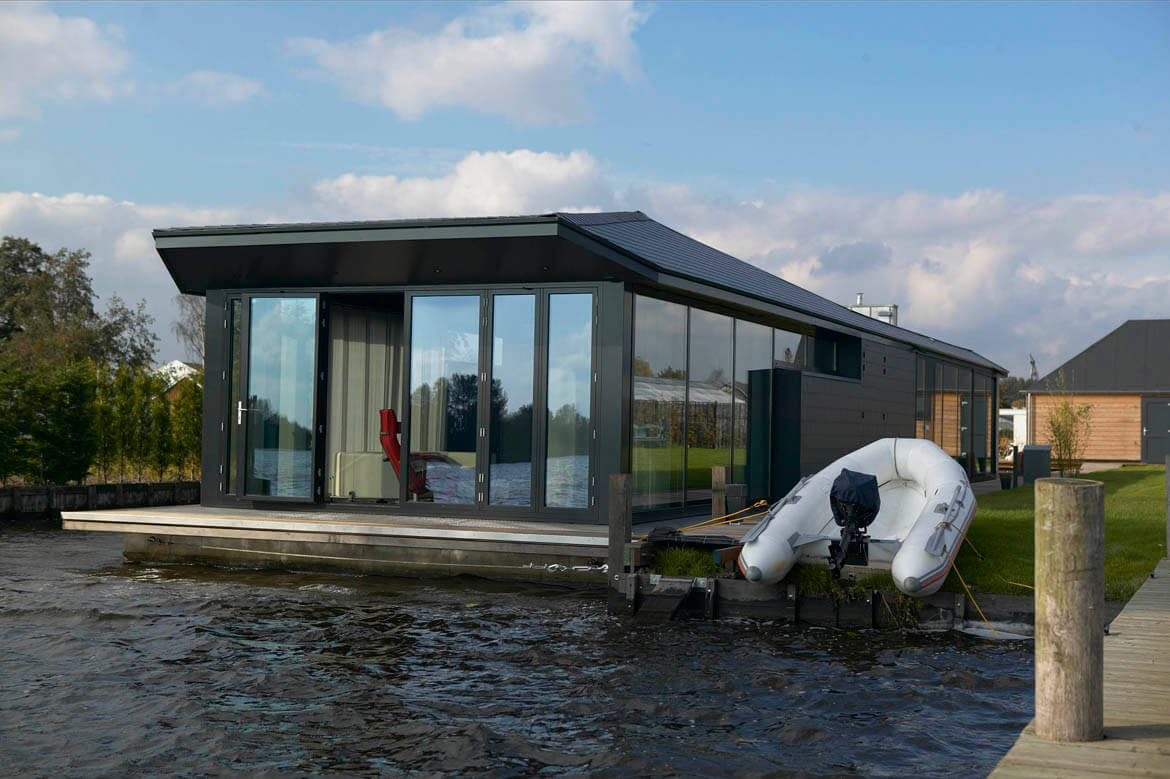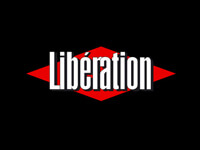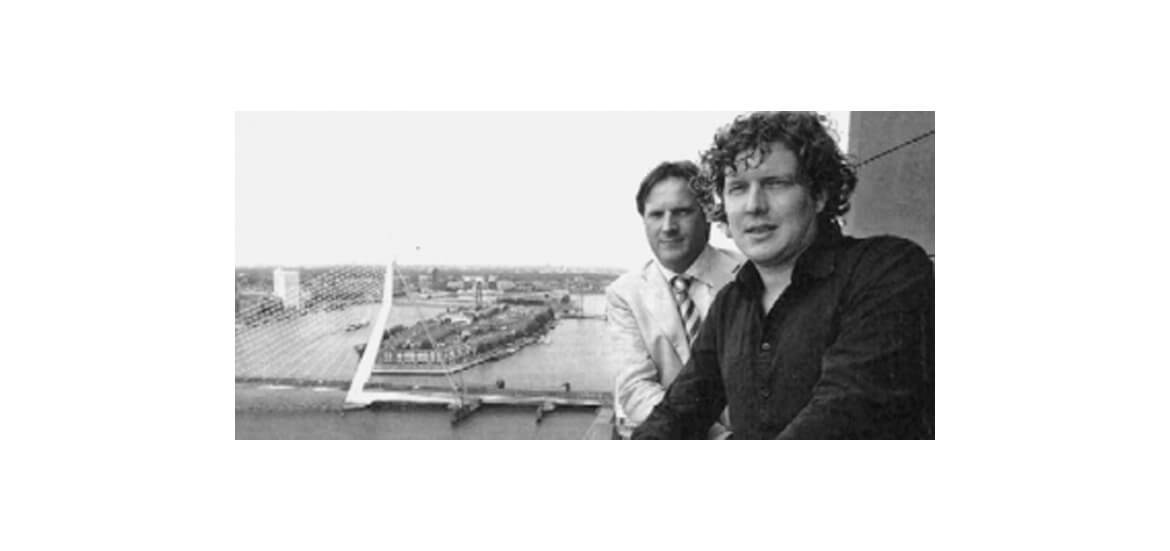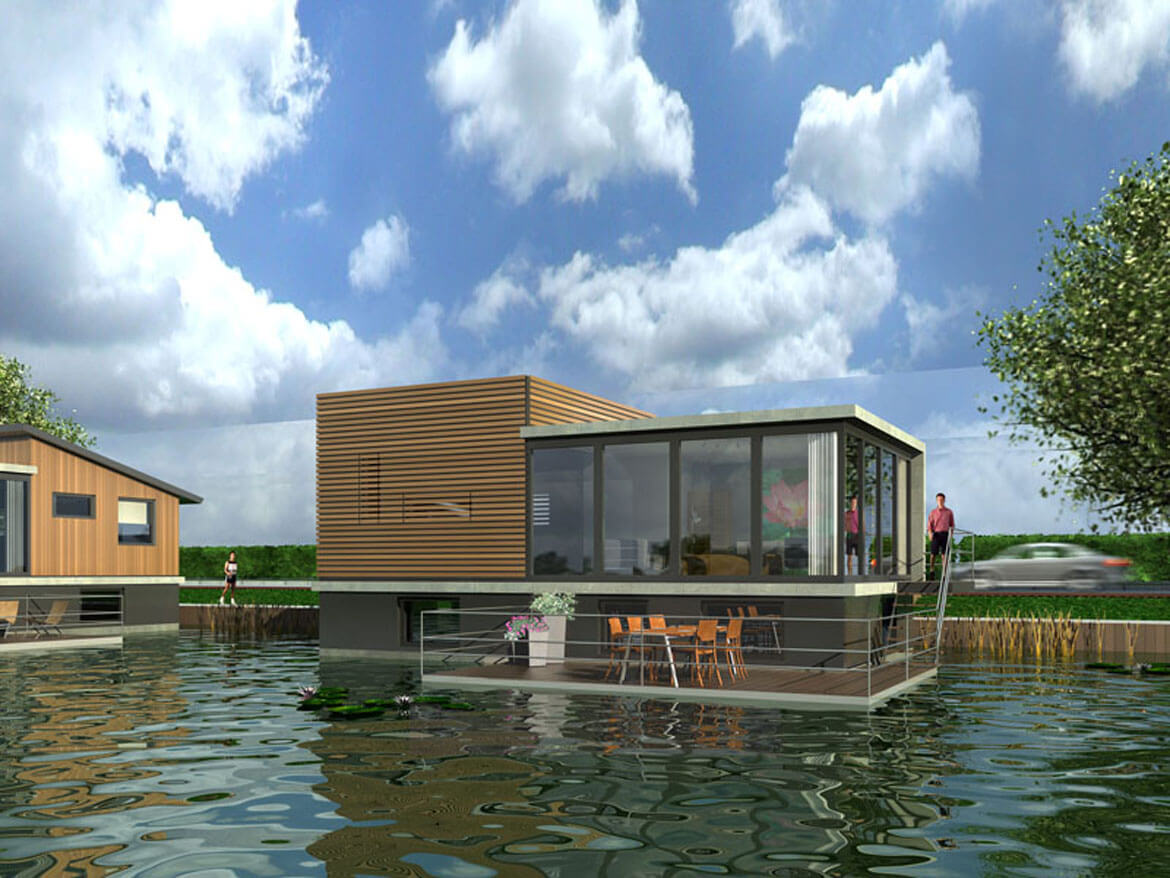Marcher sur l’eau
Liberation
Première mondiale aux Pays-Bas: des maisons flottantes en cas de montée des eaux. En attendant des villes entières.
Maasbommel (Pays-Bas) envoyée spéciale.
Sur une digue de terre, une route secondaire longe la Meuse. Un peu avant Maasbommel, un village situé à 100 kilomètres au sud-est d’Amsterdam, le paysage se fait on ne peut plus néerlandais. A droite, le plat pays à perte de vue. A gauche, les reflets des nuages dans le fleuve, les mâts d’un petit port de plaisance et, au loin, des clochers. Au détour d’un virage, un alignement surgit : 46 toits ronds sur des maisons jaunes, vertes, orange et bleues. Un lotissement comme les autres, à première vue, ultramoderne comme ils peuvent l’être aux Pays-Bas. Difficile de croire qu’à cet endroit, où se trouvait il y a dix ans un centre de loisirs, des ouvriers tchèques mettent la dernière main à un chantier unique au monde. Comme toute la région, Maasbommel a été touché, en février 1995, par la dernière grande inondation survenue aux Pays-Bas. Les pluies diluviennes de l’hiver avaient grossi la Meuse et le Rhin jusqu’à les faire déborder sur 8 % du territoire national. Pour éviter une catastrophe comparable aux inondations de 1953, qui avaient fait 1 800 morts, le gouvernement avait dû évacuer 250 000 personnes, 300 000 têtes de bétail et 1 million de cochons dans le sud-est du pays. Le bilan s’était limité à des dommages matériels.
Aujourd’hui, Maasbommel abrite les premières habitations conçues pour résister à la prochaine grande crue et éviter que leurs habitants aient à se mouiller les doigts de pied. Avec ce projet expérimental, Dura Vermeer, un des cinq plus grands constructeurs du pays, veut prouver qu’il est possible de contourner le danger. Le calcul ne se veut pas «commercial», insiste Gert Metselaar, porte-parole du groupe, mais «visionnaire». Dans un pays menacé par le réchauffement climatique et la montée du niveau de la mer, il s’agit d’anticiper. «Dans la région de Maasbommel, explique Gert Metselaar, les grandes crues surviennent tous les dix à quinze ans. Voilà dix ans que la dernière grande inondation a eu lieu. Nous saurons donc dans cinq ans, selon toute probabilité, si nos installations vont tenir le coup.» Depuis 2000, les maisons se sont bien vendues, à hauteur de 300 000 euros l’unité de 250 mètres carrés, trois chambres sur trois étages. Aucune d’entre elles, cependant, n’a encore eu à glisser le long des deux gros piliers de béton qui les arriment au sous-sol. Ces points d’ancrage, solidement enfoncés, devraient permettre aux maisons de flotter, en cas d’inondation, sans partir à la dérive.
Structures amphibies
«L’idée est si simple qu’on s’interroge», sourit Anne Van der Meulen, évacuée en 1995 du terrain de camping d’en face. Grande amoureuse du coin, cette mère de famille a été une des premières à acheter une des 32 maisons amphibies de Dura Vermeer, alors qu’elles n’étaient encore qu’à l’état de projet. A la différence des quatorze villas flottantes construites sur le même site, les structures amphibies, elles, reposent en temps normal sur un socle installé sur la terre ferme, en bordure du fleuve. Si tout se passe comme dans les plans de Dura Vermeer, à partir de 70 centimètres de montée du niveau de l’eau, ces habitations semi-flottantes se sépareront de leur socle en glissant le long de leurs deux piliers d’ancrage verticaux. Et surnageront, grâce à leur plaque de béton à fibres spéciales et galets de mousse, exactement comme leurs voisines flottantes. Tous les modèles ont été conçus pour aller jusqu’à une hauteur de 5,5 mètres, équivalente à celle de la digue qui borde le fleuve, surélevée après la grande crue de 1995. «Si l’eau va plus haut, nous aurons un sacré problème, plaisante Gert Metselaar. C’est tout le pays qui sera sous les eaux !»
Les propriétaires se disent confiants. «Je n’ai aucun doute, croyez-moi, pas peur du tout !», s’exclame Jos Verheijen, chef d’entreprise de la ville proche de Nijmegen. Dans un pays qui dénombre 9 500 péniches transformées en habitations et autres barges surplombées de villas, des polices d’assurances spéciales existent depuis longtemps. Les assureurs n’ont pas fait de problème à Maasbommel. Heureux propriétaire, Jos Verheijen ne débourse pas plus de 700 euros par an pour couvrir son nouveau lieu de villégiature et tous les biens qui s’y trouvent. Le principal tracas, en fait, est venu de l’Etat. Compte tenu du caractère expérimental du projet, le gouvernement a imposé aux 46 maisons le statut de résidence secondaire. En principe, personne n’a le droit d’y habiter à l’année, puisqu’une ancienne législation, aujourd’hui contestée, interdit aux propriétaires de maisons de vacances d’y séjourner plus de six mois dans l’année, sous peine de lourdes amendes. Si certaines mairies se montrent plus coulantes que d’autres, à Maasbommel, des inspecteurs passent régulièrement.
Des nouveaux sites
Pour les responsables de Dura Vermeer, cet obstacle est mineur. La société de BTP voit déjà l’habitat amphibie compenser 40 % du manque de terrains nouveaux, dans un petit pays déjà très construit (le plus densément peuplé en Europe), pour les développements immobiliers des cinquante prochaines années. Outre le pragmatisme néerlandais, une certaine rationalité économique devrait prévaloir : le coût de ces constructions, affirme Dura Vermeer, est moins élevé que celles sur la terre ferme du moins aux Pays-Bas, où le moindre bâtiment et même les routes exigent des fondations sur pilotis. En juin, Dura Veermer a lancé une autre première mondiale, une «serre flottante» de 600 mètres carrés ancrée dans le lac de Naaldwijk, dans l’ouest du pays. Extensible, ce prototype veut apporter une solution au manque de terres qui entrave le développement de l’horticulture aux Pays-Bas. Pour l’instant, elle sert de modèle d’exposition et se positionne comme un produit d’exportation.
Très intéressées par tous ces projets, les autorités ont identifié quinze nouveaux sites sur lesquels d’autres expériences pourront être tentées. Le ministère de la Gestion des eaux estime que 500 000 hectares de terres asséchées devront être déclarés sinistrables d’ici à 2050, en raison de la montée inexorable du niveau de la mer du Nord. Les Néerlandais ne l’oublient pas : les deux tiers de leur pays auraient déjà été engloutis sans les 3 500 kilomètres de digues, barrages et dunes entretenus par les offices locaux des eaux. Déjà, une première ville flottante de 12 000 maisons est en projet, à proximité de Schiphol, l’aéroport d’Amsterdam. Une étude de faisabilité est en cours, toujours chez Dura Vermeer, pour le chantier qui pourrait démarrer dans dix ou quinze ans. Dans un pays dont 26 % du territoire national est déjà situé en dessous du niveau de la mer, le secteur de la construction dite «résistante» n’en est bien sûr pas à ses débuts. «En ce moment, c’est de la folie !», reconnaît Koen Olthuis, fondateur en 2002 de Waterstudio, la première agence d’architectes des Pays-Bas exclusivement dévouée aux structures lacustres. Les commandes de maisons «imperméables» devraient passer de 150 unités par an cette année à plus de 20 000 en 2025, prévoit-il. L’avenir, il en est convaincu, appartient à des fondations flottantes de 100 mètres sur 100 sur lesquelles des villes entières pourraient être aménagées.
Spécialiste de la watervilla au design recherché, Waterstudio commence à recevoir des commandes du monde entier. A La Nouvelle-Orléans, des propriétaires de maisons construites sur pilotis qui se sont avérés trop courts lui ont demandé, après le passage du cyclone Katrina, de dessiner de nouvelles fondations. Parmi les projets les plus fous figure un hôtel à Dubaï. En forme d’entonnoir géant, ce gratte-ciel serait construit sur un socle rond, suivant les mêmes techniques que celles employées pour les plates-formes pétrolières offshore. Toutes les six heures, la structure effectuerait une semi-rotation, pour ne pas faire de jaloux, dans les étages, sur la qualité du panorama… En dehors des problèmes de sécurité pour les enfants en bas âge, Koen Olthuis ne voit qu’un seul inconvénient à l’habitat flottant : le parking. L’impossibilité de garer sa voiture à proximité de la porte d’entrée dissuade encore des acheteurs. «Nous trouverons bien une solution», sourit l’architecte, qui entend propager sa philosophie de «vivre avec l’eau, et non contre elle»
Afloat in the Flood Zone
The New York Times, Peter Edinin
ROM Jakarta to the coast of Louisiana, floodwaters are a growing concern. This is especially true in delta regions, where river and sea combine, as they do in many of the world’s great cities, to create a double hazard.
No place is more concerned with this problem than the Netherlands, literally “the lowlands,” where for centuries people have lived on the edge of water-borne disaster. About a quarter of the country is land reclaimed from the sea, while half of it lies at or below sea level. The country’s vulnerability to rising water levels, commonly ascribed to climate change, was on full display last summer at the Rotterdam Architecture Biennale, titled “The Flood,” which contained proposals for a floating soccer stadium and housing built on spongelike synthetic riverbanks capable of absorbing flood waters.
“Since World War II, the Dutch have relied on technology for protection from the rivers and the sea,” said Adriaan Geuze, a landscape architect and the chief curator of the biennale. “We are convinced that this is not a clever way to deal with reality, and three months after the exhibition closed, Katrina showed us the truth of that.”
For the Dutch, as for everyone else, there appear to be no simple solutions, only costly ones, like abandoning vulnerable terrain. For the first time in its long history, the Netherlands has begun to strategically uncreate itself; last year the government, at the start of a 15-year program, began buying up land and reserving it as flood plain, mostly along river banks. The Dutch are also exploring a solution as old as the first flood: floating architecture. The notion is still in its early stages, with only a handful of houses built and a few developments under way, but it has already attracted the attention of leading Dutch designers and some developers.
If it proves sufficiently functional, affordable and attractive, floating architecture could find its way to many of the world’s flood zones.
In the town of Aalsmeer, in the southwest, an area badly damaged by floods in 1953, Sjef Snel and his wife, Agnes, moved into their floating house a little more than a year ago. “It took me over six months to settle down,” Mr. Snel said, “and then I knew I was at the right place.”
Even better, Mr. Snel, 45, says he has no more concerns about flooding. “I feel totally safe,” he said. “Our living room is eight inches above water and the house is mobile. There is certainly no reason to be fearful.”
The house was designed by Agnes Snel in collaboration with Koen Olthuis, a 34-year-old Dutch architect who has emerged as a leading advocate for floating buildings. His small practice, called Waterstudio, is devoted exclusively to such projects. “Most of these projects are in the first phase,” Mr. Olthuis said from his offices in Rijswijk, “since using water, not just defending against it, is a new idea.”
Dura Vermeer, one of the country’s largest builders, is also experimenting with floating structures. It has created a community of 48 amphibious homes in Maasbommel, on the banks of the Maas river. The brightly colored 700-square-foot homes, designed by Factor Architecten, a large design firm based in Amsterdam, are set in what was once a parking area for recreational vehicles. “These are not houseboats,” said Ger Kengen of Factor. “You have to design everything as if it were on the ground, only 10 feet up in the air.”
Anna van der Molen, 45, who lives with her husband and child in one of the houses, said “not only do we live on water, but we also live with water.” The houses sit on concrete pontoons that rest on footings projected slightly above the river bottom at low water periods, but ride up during floods along a pair of 15-foot poles. Their low center of gravity, created by the weight of the pontoons, makes them very stable. Still, Ms. van der Molen said, “Sometimes it is scary, very scary, when the water is coming up.”
Chris Zevenbergen, the director for business development of Dura Vermeer, said, “We decided five years ago to take water as one of our strategic objectives. The company is also designing a “floating city,” for 12,000 people near Schiphol Airport, not far from Amsterdam, in the fastest growing area of the country. The design will cost more than $1.2 million, 45 percent of which will be paid for by the government. The goal is a town that can live with flooding, not just wall it off, using a variety of floating structures and an extensive system for rainwater storage, among other means. The challenge is aesthetic as well as commercial, notes Herman Hertzberger, who at 73 is regarded by many as the grand old man of Dutch architecture. No one yet knows what waterborne housing should look like, he said, or how it should function. Mr. Hertzberger offered some possibilities several years ago in the design of an amphibious house that revolves on a base of massive steel pontoons, turning the house, “toward the sun or away from a neighbor,” he said. The house is in Middelburg, the capital of Zeeland, the area hardest hit by the 1953 flood, which killed more than 1,800 people.
The prototype, now owned by Don Monfils, an architect, and his wife, Lidia Filius, brought a commission from a Dutch builder to create two clusters of floating houses, each set on long concrete foundations, in the same area. There will be about 20 houses in all, Mr. Hertzberger said.
But it remains to be seen how waterborne homes, as a form, will evolve.
“The problem I have is that I have not seen any great examples of contemporary floating architecture,” said Aaron Betsky, director of the Netherlands Architecture Institute in Rotterdam. “What makes a floating house different than a houseboat?”
Giving land back to the river and the sea is a solution that will create its own problems. The Netherlands is small and among the world’s most densely populated countries, so the lands set aside for water must be put to productive use.
Bart Mispelblom Beyer, a principal with Tangram, a well-known Dutch architectural office, said his firm has designed 85 houses for a tidal zone near the southern city of Dordrecht. The buildings, which will rise and fall with the tide, are being built on tidal lands because that was the only site for new homes the developer could find.
A few months ago, the Ministry of Housing, Spatial Planning and the Environment announced that it was accepting proposals to develop amphibious and other types of flood-resilient structures in 15 flood-prone areas. These are places, like the plains between rivers and the dikes that hold back their waters, in which the Dutch have never permitted construction.
Some architects remain skeptical about the large-scale feasibility of floating homes. Art Zaaijer designed six houses for a lakeside development at IJburg, outside Amsterdam. They are amphibious, and since they sit in a nature preserve, are designed to be nonpolluting.
Unfortunately, Mr. Zaaijer said, development has been stalled by an economic slowdown, and his houses, he said with a mixture of amusement and chagrin, have been occupied by squatters. “There are squatters from all over the world there,” he said, “totally happy, living in exceptional houses with wonderful views. Last time I went by I met a group of Brazilian painters.”
Mr. Zaaijer clearly loves these homes, but he is skeptical about the contribution such structures will make. “We have six or seven million houses in Holland,” he said, “and this will always be a marginal addition to them.”
Mr. Betsky is not quite so pessimistic, but he acknowledges significant obstacles. “In most of the designs I’ve seen,” he said, “the houses are isolated objects connected to the shore by a thin umbilical cord.”
“A luxurious isolation tank seems to be the destiny of many Dutch lakes and rivers,” he added. “Might there be a community like what one finds in Southeast Asia, where the houses connect to each other as well? I am still looking for good examples.”
Dutch design lets homes float on the floodwaters
Dutch design lets homes float on the floodwaters
By Matt Bradley, Contributor to The Christian Science Monitor OCTOBER 26, 2005
‘God created the earth,” says an old Dutch saying. “but the Dutch created the Netherlands.” Indeed, precious few nations share the distinction of having forged much of their land from the sea.
After hurricane Katrina flooded the Gulf Coast, many US hydrologists, architects, and city planners looked to “the low countries” for water-wise guidance. But instead of continuing their prohibitively high-cost war against the sea, some Dutch architects are designing ways to live on, instead of fighting against, the rising tide.
Amphibious housing – structures built on land that rise and fall with the water level – is one of several innovative ideas.
Recommended: Could you pass a US citizenship test?
“We have to redefine construction to make it more dynamic and less static,” says architect Koen Olthuis in a phone interview from Waterstudio.NL, an amphibious housing design firm in the Dutch city of Rijswijk. “We call this the ‘resilient sector.’ If a house is resilient, it means there won’t be any damage or loss of value from flooding.”
The Netherlands topography resembles that of New Orleans, only on a far grander scale: Some 26 percent of the country lies below sea level. Much of its land has actually been reclaimed from lakes, bays, and rivers, and is protected by an aging, complex system of dikes (similar to New Orleans levees) and water pumps (think of the famous Dutch windmills).
But after nearly a millennium of digging, pumping, and filling, the Netherlands is still extremely vulnerable to harsh weather and now, to global climate change. As sea levels rise, some experts say it’s high time to make peace with the sea once and for all.
Residents are already moving into the first development of “amphibious” and floating houses on the banks of the Meuse River in Maasbommel, about 100 miles southeast of Amsterdam. When it is completed in January or February, the development (built by Dutch construction company Dura Vermeer and designed by architect Ger Kengen) will include 15 floating and 34 amphibious homes.
Whereas classic construction techniques in the Netherlands rely on underground concrete pilings to support structures in the spongy soil, an amphibious house comes with foam built into a hollow concrete basement.
When the water rises or falls, the houses float to up to 18 feet above ground by sliding along two mooring poles at the front and rear of the buildings. With the help of flexible PVC piping, the plumbing, electrical, and natural gas connections can go along for the ride.
The floating houses – similar to houseboats – manage rising and falling water levels in much the same way, but are built to float year-round, no matter what the weather.
“There will be a lot of turbulence,” says Dick van Gooswilligen, Dura Vermeer’s spokesman. “But on the other hand, the house is connected to the two mooring poles which would keep the house stable. So you would feel the waves, but it wouldn’t be extreme.”
While flooding is a perennial issue, the Netherlands rarely finds itself in the path of truly rough weather.
The new amphibious and floating houses are not built to withstand hurricanes or typhoons, but Mr. Olthuis’s designs present nearly the same structural challenges as their land-lubbing relatives: Both need extra fortifications to withstand high winds.
Wetter winters and drier summers will make for unpredictable water levels in large parts of the Netherlands. Some 1.2 million acres of dry land will need to be reallocated as flooding zones in the next 50 years, according to government calculations. The Dutch Ministry of Water Management and Traffic has designated 15 areas where Mr. van Gooswilligen expects to someday see homes, businesses, and even agriculture bobbing placidly on the waves.
The new community at Maasbommel includes the world’s first floating greenhouse.
“They have been talking for years about building on and around water,” says van Gooswilligen. “And we said, ‘Stop talking. Don’t tell them, show them that it’s technically possible to build houses that are waterproof and safe.’ ”
Understandably, the act of building in flood zones raised a few eyebrows, even among the water-savvy Dutch. Before it became a testing ground for revolutionary architectural methods, Maasbommel had seen two floods in 1995 and 1997 that devastated what was once a riverside recreational park. The massive property damage made authorities reluctant to re-develop the area. Van Gooswilligen says that while the first project is small and experimental, he expects many more to come.
“It’s no longer going to be developments with 49 houses and one greenhouse,” he says. “Everyone’s going to have to take a step forward, and we’re going to build in a different way.”
Despite its unusual “resilient” construction, a well-designed, inland amphibious building can blend in with a surrounding neighborhood’s architectural style.
“If you’re walking through Amsterdam, you can’t see that the city is built on hundreds and hundreds of [underground] piles,” says Olthuis. “We can build in a floating way, so people walking through Amsterdam won’t see any difference.”
Camouflaging the flood-proof buildings would mean outfitting the old “polder” system of concrete pilings with amphibious technology. Such a strategy might also help save Venice’s rapidly sinking skyline.
The amphibious technique lends itself primarily to new construction. Flood-proofing older buildings might be prohibitively expensive, Olthuis says. The new flood-proof design, however, spares the builder significant waterproofing expenses required by law in many Dutch communities.
City planners are not only racing against the rising tides. Rapid urbanization and massive population growth may force a massive exodus onto the water, designers say.
“We feel that in order to cope in 2050, with 9 billion people on Earth, you need to take into account this opportunity to provide people with basic elements needed to sustain life,” says Frits Schoute, a retired Dutch engineering professor who is now devoting his time to his dream of living on the sea. (Dr. Schoute’s designs can be found on his website, www.ecoboot.nl.)
One of Schoutte’s designs features dampers that would not only protect floating houses from waves, but would also act as generators to exploit the tides for electrical energy. Based on his preliminary calculations, wave dampers could provide more than enough electricity to live indefinitely on one of Schoutte’s “ecoboats,” he says.
As for the commercial success of amphibious and floating houses, Olthuis cites one persistent truth: Coastal views have always commanded premium prices.
Next November, Olthuis and his firm plan to present designs for a 400-foot-tall floating hotel in Dubai on the Persian Gulf, a city that frequently courts innovative (sometimes outlandish) design solutions.
The circular hotel, which will sit only 12 to 16 feet deep, will rotate every six hours to offer guests unobstructed views of the city’s arresting skyline.
“It’s spectacular,” Olthuis says. “I think we’re only on the first step with these innovative possibilities of living on or next to the water. We all say here, the future is wet, and the future is great.”
Niets staat uitbundige architectuur op water meer in de weg
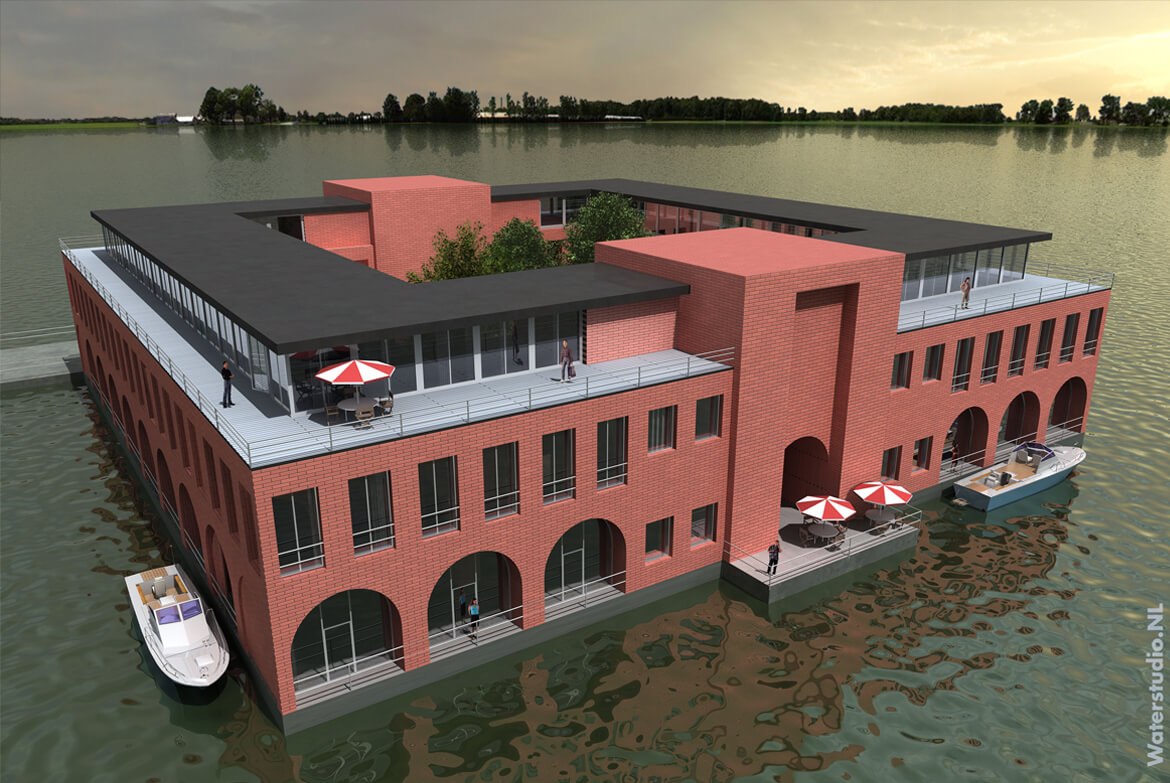
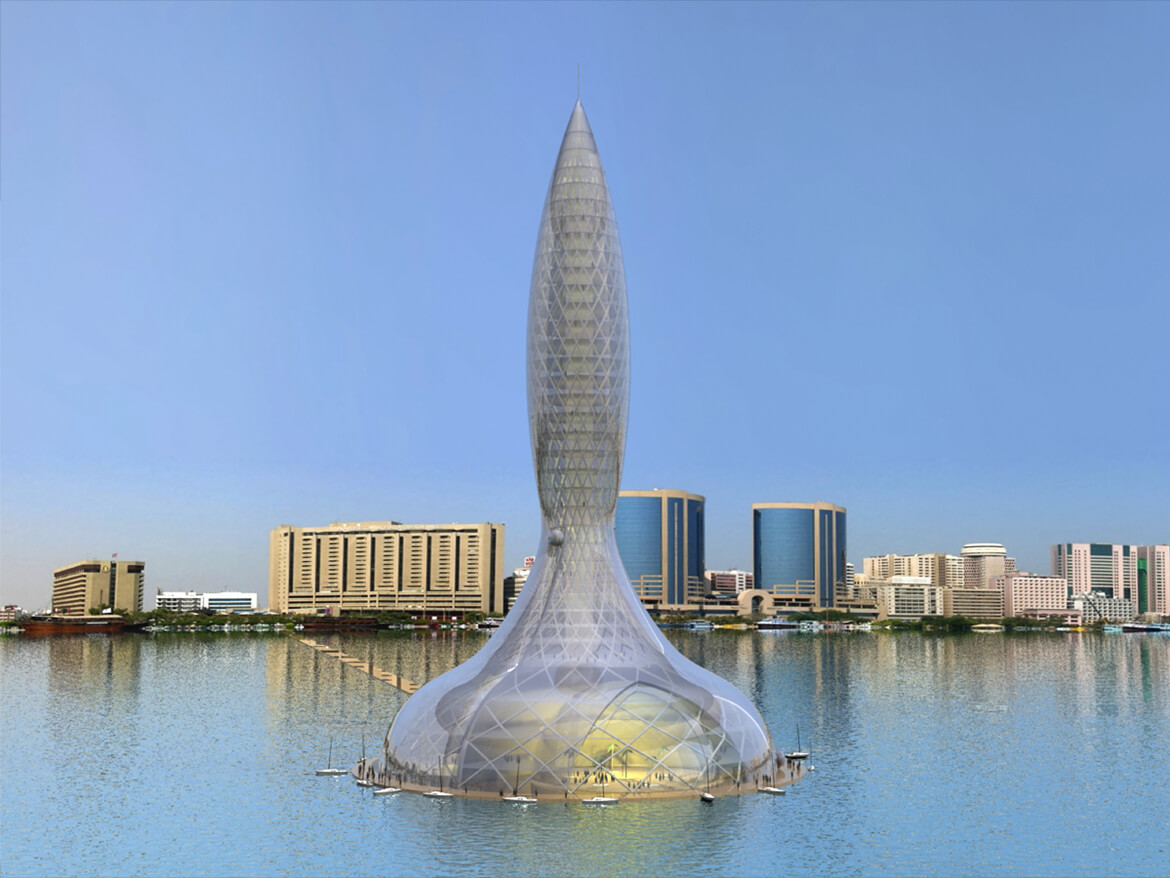
Cobouw, Inge Pranger
rijswijk – De eerste echte opdracht is al binnen: een drijvend hotel van 45 bij 80 meter in een baai van Aruba. Architect Koen Olthuis van Waterstudio.nl ziet de toekomst duidelijk voor zich. Drijvende steden, uitbundige architectuur op het water. “Het is nu slechts een kwestie van afwachten.”
“De techniek is betaalbaar, het patent op de bouwgrond is beschermd, uitgewerkt en doorgerekend”, zegt Olthuis. Niets staat grootschalig bouwen op water meer in de weg, behalve regelgeving en een opdrachtgever die durft.
Waterwoningen en grote boorplatforms op drijvende elementen zijn niet nieuw. Maar wel de manier waarop modules van 100 bij 100 meter aan elkaar kunnen worden gekoppeld en een complete woonwijk op het water is te bouwen. Ideeën hierover als oplossing voor woningnood en tot nu toe onbewoonbare overloopgebieden bestaan al lang, maar die stap zijn we volgens Olthuis voorbij. “De volgende stap is een giant leap, het kan stedenbouw wereldwijd veranderen”, verzekert hij omdat het nu uitvoerbaar is.
Olthuis en zijn compagnon Paul van de Camp, directeur van Dutch Docklands International (DDI) kozen de WaterfrontExpo in Riga uit om naar buiten te komen met bouwplannen als drijvende restaurants en hotels tot boulevards met een oppervlakte van 8000 vierkante meter.
Het basisidee voor de nieuwe bouwtechniek van aan elkaar geschakelde drijvende pontons van betonnen elementen en piepschuim was een half jaar geleden al klaar, maar het duo wilde eerst patent aanvragen op de nieuwe methode.
Experimenten
“Achteraf bekeken hadden we geen beter moment kunnen uitkiezen”, zegt projectontwikkelaar Van de Camp. “Staatssecretaris Schultz heeft niet voor niets pas geleden vijftien locaties aangewezen waar mag worden geëxperimenteerd met buitendijks bouwen. Met de watersnoodramp in New Orleans en de tsunami nog vers in het geheugen, heeft de waterproblematiek wereldwijd nog nooit zo hoog op de agenda gestaan.”
“Tot nu toe zijn we alleen maar gewend geweest te vechten tegen het water”, vult Olthuis aan. “Maar van het water verlies je het altijd. Het is veel te sterk. Dat blijkt keer op keer. Heel vervelend natuurlijk, maar het draagt wel bij aan een veranderende mentaliteit, het besef dat de knop om moet.”
Met TNO, die het concept de komende jaren doorontwikkelt, is een exclusiviteitsovereenkomst gesloten. Het onderzoeksinstituut heeft de drijvende bouwgrond op een levensduur getest van honderd jaar. Olthuis: “Eerst voor rustig water met weinig stroming, later volgen de rivier en open water met sterke stroming tot bij wijze van spreken gigantische plateaus de hoogste golven afdekken op de meest wilde zee, zonder dat er iets van deining is te merken.”
Vijf jaar geleden besloten de waterbouwers de koe bij de hoorns te vatten. Ze hebben een paar grote bedrijven laten uitrekenen wat het kost om aan elkaar geschakelde pontons in grote oppervlakten te fabriceren. Technisch kan het, zo luidde de conclusie, maar wel voor zon 1800 euro per vierkante meter. Economisch bleek het niet haalbaar.
Van de Camp: “Toen zijn wij zelf aan de slag gegaan. Door alle tot nu toe bedachte oplossingen en technieken te mixen en het eisenpakket helemaal terug te brengen naar de basis. Waar moet de bouwgrond aan voldoen? Het moet betaalbaar zijn en overal, waar ook ter wereld prefab in forse hoeveelheden kunnen worden geproduceerd in goed verkrijgbare materialen. Dat scheelt transportkosten, bovendien genereert het werk. Wij zijn geen bouwers. Wij leveren het concept en het recept, waarna de lokale aannemer kan bouwen.”
Het schakelsysteem maakt een stedenbouwkundige structuur mogelijk à la Amsterdam, “of wat dacht je van Venetië met pittoreske kronkelige kanaaltjes”. “We kunnen Amsterdam dat vanwege de drassige ondergrond ooit op palen is gebouwd, met de huidige technieken zo opnieuw bouwen, alleen drijvend.”
De ogen van Olthuis glimmen bij het idee van de uitzinnige architectuur die mogelijk is op het water, onontgonnen gebied waar nog alles kan. Hoe de ingekakte architect van tegenwoordig, die allang geen bouwheer meer is, zijn rol als creatieve richtinggever weer op zich kan nemen en er een hele nieuwe architectuurstijl kan ontstaan.
De waterbouwers staat te popelen de Nederlandse pioniersgeest weer nieuw leven in te blazen. Olthuis: “Wat nu innoveren op gebied van ict? Neem water als exportmiddel! BV Nederland Waterland, we zijn er groot mee geworden. Baggeren, deltawerken en hoogstaande offshoretechnieken.” Had dit idee in een ander land kunnen ontstaan? Het duo weet wel zeker van niet.
Bouwprojecten in portefeuille
Vanwege de ingewikkelde regelgeving in Nederland hebben Waterstudio.nl en DDI besloten eerst op internationaal projecten in te zetten. Van de Camp: “We houden een zwak voor Nederland, maar een oliesjeik heeft van niemand goedkeuring nodig. Hij zet zijn handtekening en dan kunnen we morgen beginnen.”
Zodra de opdrachtgever op Aruba de financiering rond heeft begint de bouw van het drijvende hotel. Half november vertrekt Van de Camp naar drie van de Verenigde Arabische Emiraten waar belangstelling is voor een drijvende ronddraaiende toren van 100 meter hoog (doorgerekend door DHV Rotterdam).
Bouwen met veerkracht


Stedebouw & Architectuur, Koen Olthuis
The Future is wet, the future is good
Dutch Answer to Flooding: Build Houses that Swim
Der Spiegel
Looking out from the terrace, heaven and earth merge into a grey blur. Heavy rain pours so incessantly that one would expect Anne van der Molen to be getting just a little nervous.
“Tomorrow does not look any better, according to the weather forecast,” she says, calmly sipping her coffee. She does so in spite of the fact that her house stands directly on the Maas dyke – on the side facing the river, to be exact. Yet the nurse, sitting on her garden chair under the awning, feels as cozy and safe as if she were “snowed in up in a mountain hut, with a log fire glowing and the pantry full.” The Maas can go on rising as much as it likes, for all she cares. Her house can swim. As the water level climbs, the house itself can move up five meters, if necessary. “The elements don’t bother me,” she says.
There are 37 houses strung along this branch of the Maas like a row of beads. At first glance, they seem quite unremarkable. Two storeys high, semicircular metal roofs and yellow, green or blue facades – hardly any clues let on that these are The Netherlands’ first amphibious houses. The cellar, in this case, is not built into the earth. Instead, it is on a platform – and is much more than a mere storage room. The hollow foundation of each house works in the same way as the hull of a ship, buoying the structure up above water. To prevent the swimming houses from floating away, they slide up two broad steel posts – and as the water level sinks, so they sink back down again.
“The columns have been driven deep into solid ground,” explains Dick van Gooswilligen from the Dura Vermeer construction company. “They are even strong enough to withstand currents you would find on the open seas.” Gooswilligen is currently busy guiding dozens of journalists from the United States through the watertight settlement in the Maasbommel district, close to Nijmegen. “As global warming causes the sea level to rise, this is the solution,” he explains into a microphone. “Housing of this type is the future for the delta regions of the world, the ones which face the greatest danger.”
Soundbites like these are just what Americans want to hear these days. Hurricane Katrina and her lesser cousin Hurricane Rita have sparked interest in the low lying Netherlands. Hordes of hydraulic engineers from Louisiana or Texas are making the pilgrimage to the North Sea coastline to look at the fortifications. The inland river dykes are also considered exemplary models.
The Netherlands Sinks a little Lower Every Year
German catastrophe management teams are just as curious. Climate patterns today suggest that torrential rainfall is something we can expect plenty more of in the future. This year’s floods in the Alps or those along the River Elbe three years ago could well be warning signs of what awaits us. Climatologists predict that precipitation in The Netherlands could increase as much as 25 percent. At the same time, because of the small kingdom’s dense population, there is increasing pressure to build in areas prone to flooding. Already, though, the country defies the laws of physics simply by existing: More than a quarter of its land lies below sea level. And, year by year, the land is sinking a little bit lower. The Dutch protect themselves from going under through a network of canals and pumps. It is not only the sea which threatens the mighty barrage on the coast. On the other side lies the Rhine River, which branches out and forms a wide-reaching delta with the Maas. To prevent such huge swaths of land from flooding in summer and winter storms, the Dutch are designating more and more land along their rivers as flood zones. Within the next few decades, the area will compose close to 500,000 hectares — or about twice the size of the German state of Saarland.
This will only be possible if people, industry and agriculture can be successfully relocated to safe territory – which is hard to imagine, given the resistance mounted by some of those affected. Officials have, therefore, decided to demonstrate first of all that it is possible to live in the so-called flood zones. In early October, 15 test areas were announced. A stringent ban on construction in these areas has now been lifted – provided buildings constructed are amphibious houses and nothing else. This means that, in a worst case scenario, excess water from flooded rivers can still be diverted this way.
“You cannot fight water, you have to learn how to live with it”, states Sybilla Dekker, the minister in charge. Her department has arranged a competition for engineers, urban planners and architects to design living accommodation, greenhouses, parking lots and factories which would float and could grow into “waterproof” towns.
One of the leading architects in this relatively new discipline of maritime architecture is Koen Olthuis. His aptly named Waterstudio.nl office has already designed a number of contemporary houseboats with a parking deck for the car and lower deck storage for a motorboat. Now, his team is even coming up with plans for office buildings a hundred meters in height that “swim.” The key to making this idea a reality is a patented technique whereby the foundation of the construction can be transformed into a float. A foam core is encased in concrete, with steel cables securing it against the pull of potential currents. Individual pontoons, whether for residential blocks or chicken coops, can be joined to one another like Lego blocks. As a result, a maritime settlement is born.
“This construction model is built to last at least one hundred years,” Olthuis says. If anything should happen to the foundation, there is no need to call in the construction company. Instead, the whole thing can be taken to the dockyard.
Family “arks” of the future
The architect from Rijswijk hopes to tap into a worldwide trend. Increasing numbers of people are gravitating towards the water, out of necessity, for financial gain or, in some cases, quite simply for the wonderful view. “Thanks to watertight buildings, this impulse need not be fateful,” he says. His bobbing buildings have not only found favor in the Polder lands, he has also prepared concepts for Dubai.
The first town based on this model, numbering 12,000 houses, might conceivably be built close to Amsterdam’s Schiphol airport. The Netherlands are particularly low in this area. When planes come in for a landing here, one can see countless rectangular islets amid a picturesque, watery landscape. Canals weave their way like veins through the swaying reeds of green land which invariably opens out into ponds or lakes. By the year 2010, amphibious houses like those in Maasbommel may well form the first residential area here – or perhaps greenhouses will dominate the landscape, like the one opened earlier this month by the minister of agriculture in The Hague.
At this stage, such model houses cost more than conventional housing. The amphibious buildings in Maasbommel cost approximately 250,000 to 300,000 for a 120 square meter home. This is due in part to the flexible nature of the construction which also plays a role in creating feed lines for gas, electricity, drinking water and drainage. Like the foundation, they, too, have to be able to adapt to the changes in height of the premises.
But, when the floating construction model goes more mainstream, the price of a one family “ark” should drop dramatically. “At the end of the day, we will save on a lot of the costs conventional building methods incur doing things like securing foundations in soft ground. We won’t have to contend with that,” Olthuis points out. It remains an utter mystery to him why water-proofed construction is not yet common practice.
He can only watch and shake his head as his television broadcasts fresh pictures of floods in one part of the world or another. “Those people, breaking their backs piling sandbags on their doorsteps, I feel really sorry for them.”
